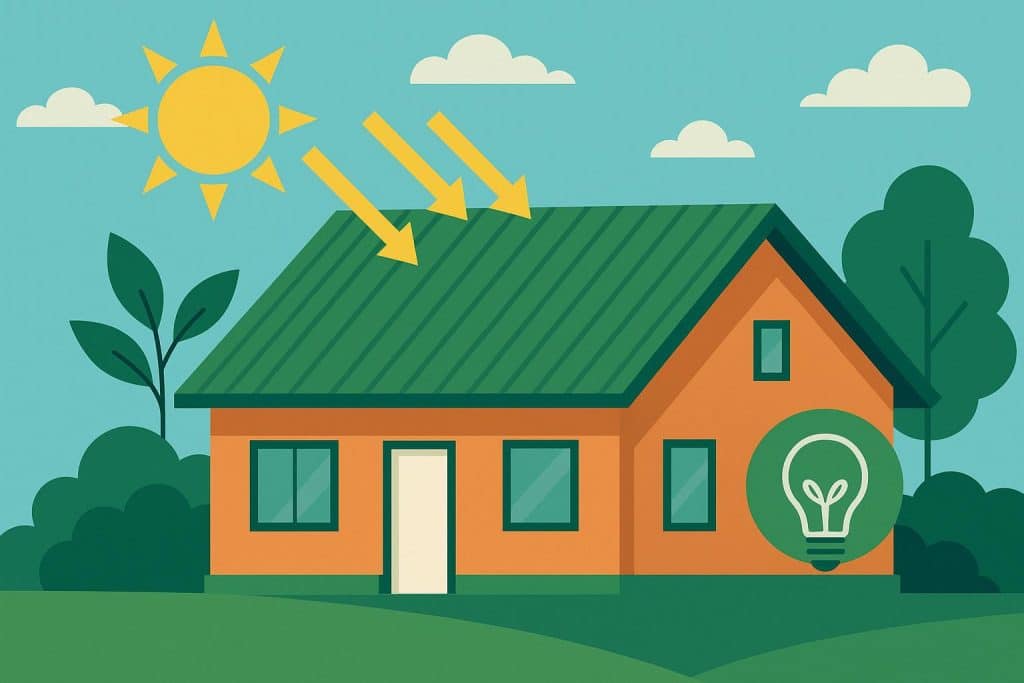More and more Texas homeowners are choosing metal roofs to help cut energy costs and make their homes more efficient. Homeowners are feeling the pinch of rising energy bills while also becoming more conscious of their environmental impact. Modern roofing technology has evolved to address both financial concerns and ecological responsibilities through innovative material engineering.
Building envelope decisions significantly influence household energy consumption patterns. Sustainable metal roofing materials demonstrate measurable performance advantages that extend beyond traditional roofing functions. This blog examines how these advanced materials create tangible energy efficiency improvements for residential properties.
Heat Reflection Properties Reduce Cooling Demands
Metal roofing surfaces naturally deflect substantial portions of incoming solar radiation. This deflection prevents excessive heat accumulation within attic spaces during peak daylight hours. Advanced surface treatments further enhance these natural characteristics through specialized reflective technologies.
Cool roofing coatings applied to metal surfaces can redirect up to 80% of solar energy away from building structures. The reduced heat absorption keeps roof surface temperatures significantly lower than conventional alternatives. Air conditioning systems require less energy to maintain comfortable indoor environments when roof heat gain decreases substantially.
Thermal Performance Through Seasonal Changes
Eco-friendly materials help keep indoor temperatures stable, no matter the weather outside. The materials contract and expand predictably without compromising structural integrity or energy performance characteristics. Winter heating efficiency improves through effective thermal barrier properties that prevent heat loss.
Metal roofing systems create stable indoor temperature conditions regardless of external weather fluctuations. The thermal mass characteristics help regulate interior environments naturally without excessive mechanical system intervention. Energy consumption patterns become more predictable and manageable throughout different seasons.
Manufacturing and Material Sustainability
Modern metal roofing uses a lot of recycled content, making it a greener choice for homeowners who care about sustainability. Steel roofing products typically contain 60-90% recycled materials, while aluminum options may reach even higher percentages. Manufacturing processes have become increasingly energy-efficient through technological improvements.
Production facilities employ advanced techniques that minimize energy consumption during fabrication stages. The manufacturing carbon footprint continues to decrease through improved efficiency standards and renewable energy adoption. Sustainable roofing materials maintain quality standards while reducing environmental impact during creation phases.
Ventilation Enhancement and Air Circulation
Metal roofing installations facilitate superior ventilation system performance through complementary design principles. Proper air circulation beneath metal surfaces prevents moisture accumulation while maintaining ideal thermal conditions. Ridge ventilation combined with wave intake systems creates natural airflow patterns that reduce mechanical ventilation requirements.
Enhanced air movement patterns contribute significantly to overall building energy efficiency through passive cooling mechanisms. The natural ventilation approach reduces electrical consumption from powered ventilation systems. Temperature regulation becomes more effective when metal roofing works alongside well-designed ventilation strategies.
Durability Extends Energy Efficiency Lifespan
Metal roofs hold up their energy-saving benefits for years without losing effectiveness. The materials resist weather-related damage that commonly affects other roofing options in challenging climates. Several factors contribute to this sustained performance advantage:
- Reflective surface properties resist fading from sun exposure
- Thermal expansion characteristics remain consistent over time
- Weather resistance prevents air leaks that compromise efficiency
- Surface integrity maintains optimal heat reflection capabilities
- Minimal maintenance requirements preserve energy performance standards
Integration with Modern Energy Systems
Contemporary sustainable metal roofing materials accommodate various energy technologies without structural complications. Solar panel integration becomes straightforward due to metal roofing’s load-bearing capacity and mounting compatibility. The combination creates synergistic effects that enhance overall property energy independence.
Smart building technologies pair effectively with metal roofing’s thermal characteristics for enhanced energy management. Temperature monitoring systems can track efficiency improvements and demonstrate measurable conservation results. Energy management platforms recognize the stable thermal properties that metal roofing provides for more accurate climate control programming.
The combination of superior heat reflection, thermal stability, manufacturing sustainability, and extended durability creates lasting value for environmentally conscious property owners. Energy conservation becomes achievable through strategic material selection that supports both immediate efficiency needs and long-term environmental goals. Metal roofing represents a practical solution for residential energy efficiency.

